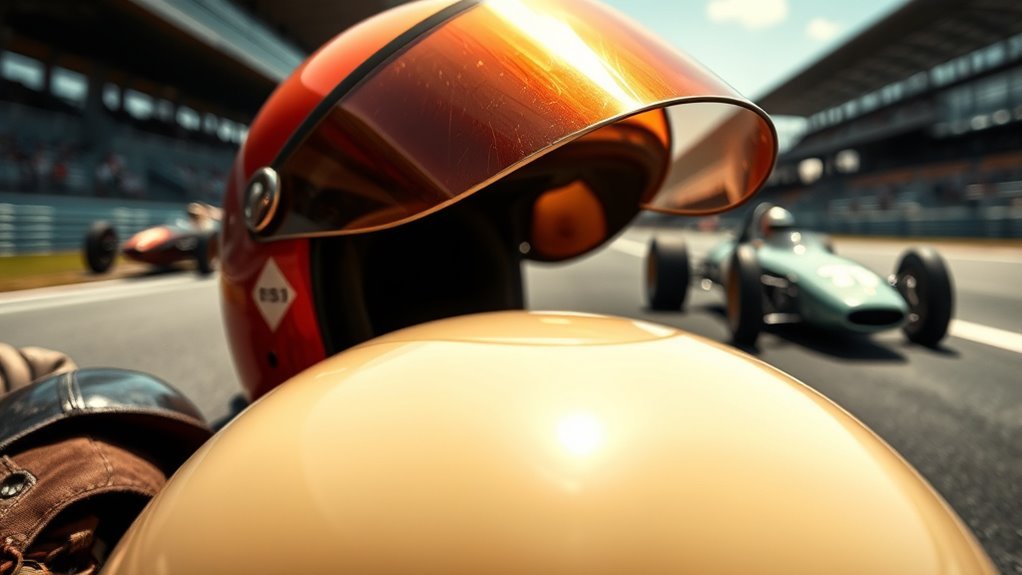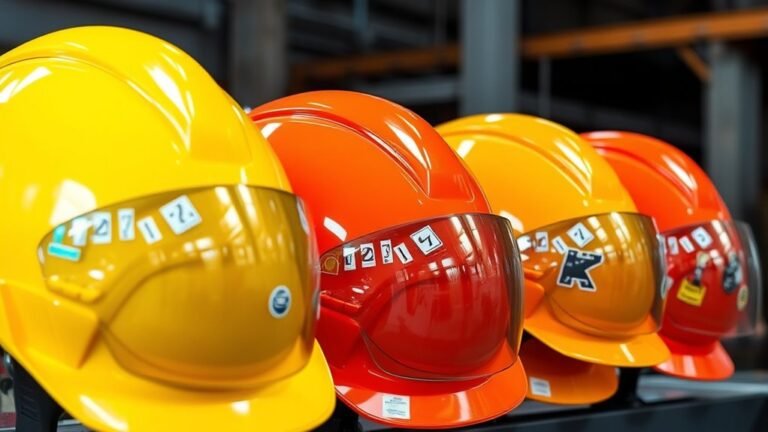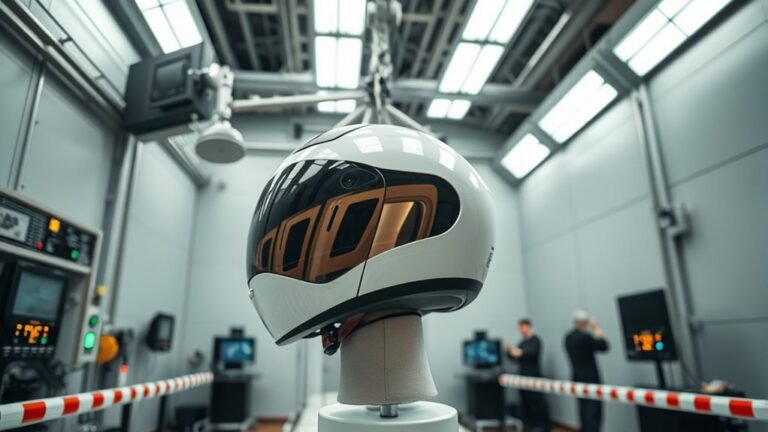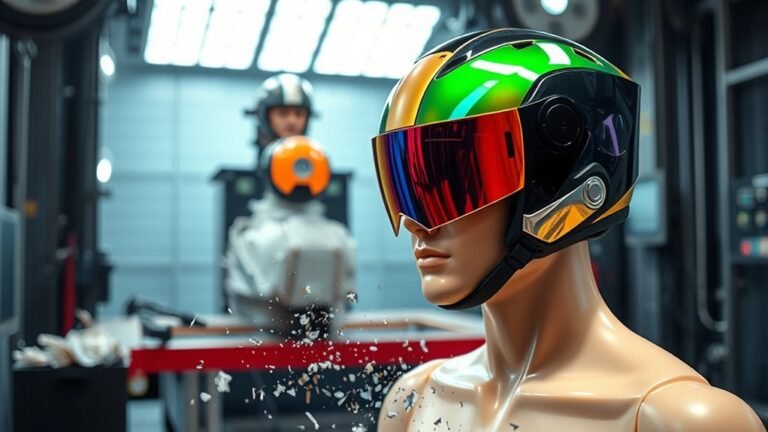How Helmets Became Mandatory in Motorsports
Helmets became mandatory in motorsports after devastating accidents and fatalities highlighted the need for improved safety measures. Early racing culture prioritized thrill over protection, leaving drivers vulnerable to serious head injuries. As advocacy grew among drivers and teams, regulatory bodies stepped in to enforce helmet laws, markedly reducing head injuries and changing safety perceptions. This shift not only enhanced protection but also transformed the racing experience. Discover how these changes influenced the sport’s safety culture and technology advancements.
The Early Days of Racing: A Lack of Head Protection
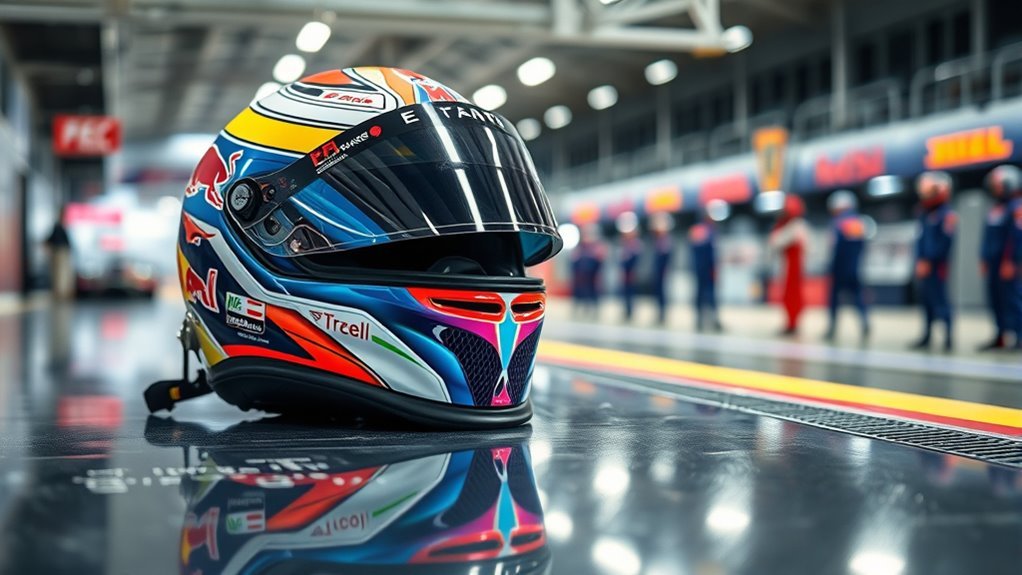
In the early days of racing, when speed and thrill took precedence over safety, drivers often took to the tracks without any head protection. This era fostered a racing culture where risk was a badge of honor, and the driver mindset glorified bravery over caution. You could feel the adrenaline coursing through the veins of those daring individuals, who believed they were invincible, chasing freedom on open roads. The roaring engines and the smell of burning rubber fueled their passion, overshadowing the dire consequences of head injuries. As exhilarating as it was, this reckless disregard for safety highlighted a critical gap in the sport, ultimately paving the way for revolutionary changes. It was a thrilling yet perilous time, where the need for protection would soon become undeniable.
The First Helmet Innovations
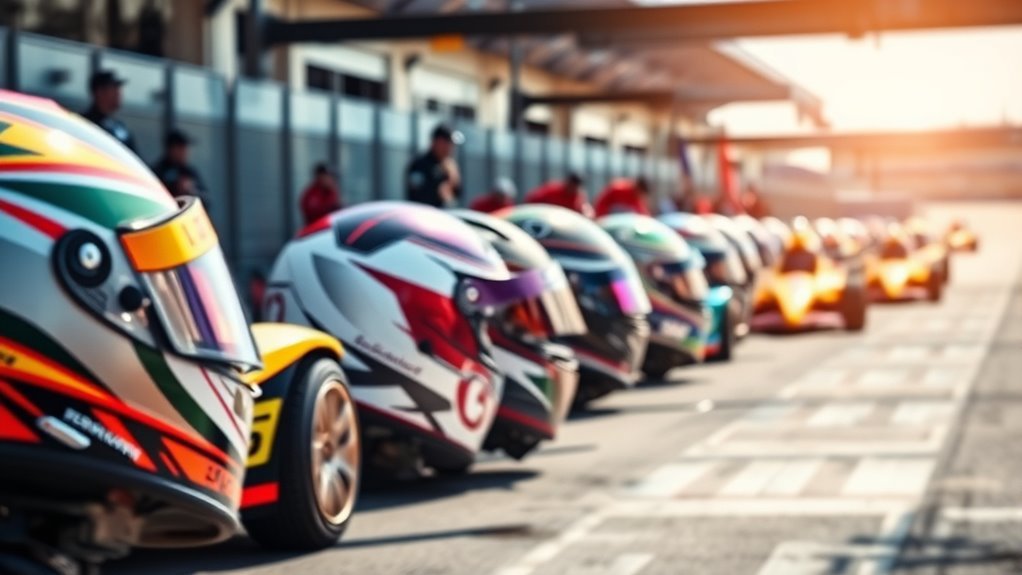
Throughout the 1950s, the need for driver safety became increasingly apparent, leading to the first significant innovations in helmet design. Early helmet designs were often little more than hard hats, offering minimal protection. However, as awareness of head injuries grew, engineers and racers began experimenting with materials like fiberglass and expanded polystyrene, which provided better shock absorption. These safety innovations not only improved the helmets’ structural integrity but also made them more comfortable and lightweight. This shift marked the beginning of a transformation in motorsport safety culture, as drivers started to prioritize their protection. The evolution of helmet technology reflected a growing commitment to personal safety, paving the way for future advancements that would ultimately save lives on the racetrack.
Influential Accidents That Changed Perceptions
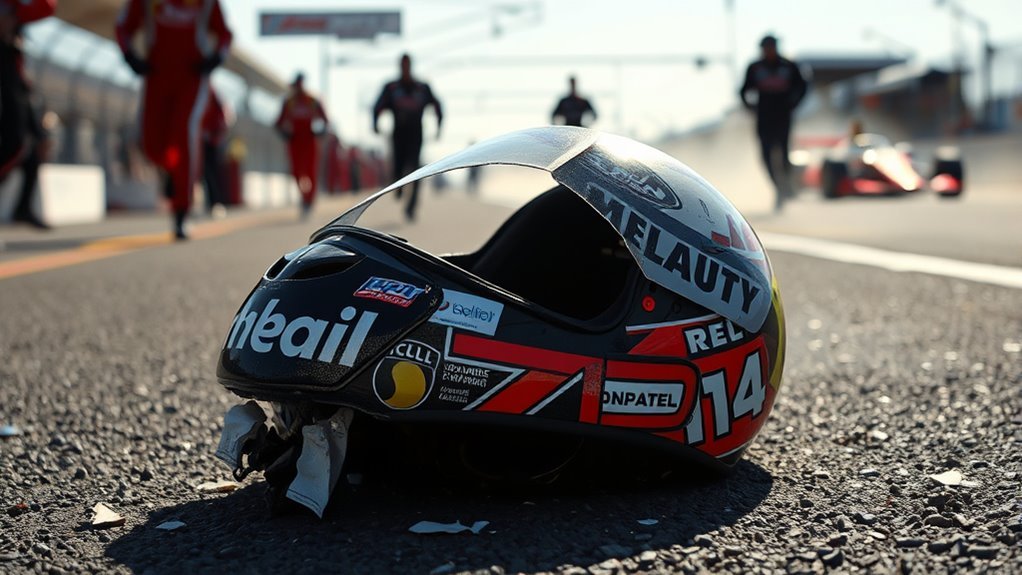
Throughout motorsports history, several tragic accidents have dramatically shifted the perception of safety, especially regarding helmet use. You might be surprised to learn how early fatalities and iconic crashes prompted immediate changes in regulations and influenced the push for mandatory helmet legislation. These events not only highlighted the dangers of the sport but also sparked a critical conversation about protecting drivers on the track.
Early Fatalities Impacting Safety
Though motorsports have always been thrilling, the tragic fatalities that marked the early years of racing served as stark reminders of the inherent dangers involved. These fatal accidents shook the racing community, igniting a vital shift in safety awareness. You might recall the high-profile crashes that claimed lives, prompting both drivers and fans to confront the reality of risk in pursuit of speed. As the sport evolved, it became clear that protective measures were essential. The heartbreaking losses highlighted the necessity for better safety protocols, leading to a collective demand for change. This awakening transformed motorsports, paving the way for innovations like helmets, ensuring that the thrill of racing could coexist with the imperative of safeguarding lives.
Iconic Crashes and Changes
As the racing world faced devastating accidents, some iconic crashes became crucial moments that reshaped safety perceptions. These events sparked intense crash analysis and highlighted the urgent need for safety evolution in motorsports. You might remember names like Ayrton Senna and Dale Earnhardt, whose tragic fates ignited conversations about helmet standards and driver protection.
| Crash Event | Year | Safety Changes Implemented |
|---|---|---|
| Senna’s Accident | 1994 | Improved helmet technology |
| Earnhardt’s Crash | 2001 | Mandated head and neck restraints |
| Zanardi’s Incident | 2001 | Enhanced cockpit safety measures |
| Wheldon’s Crash | 2011 | Stricter helmet regulations |
| Bianchi’s Accident | 2014 | Reinforced safety barriers |
These incidents remind us that every crash can lead to essential change in the pursuit of safety.
Legislation Following Tragedies
The push for improved safety in motorsports didn’t just stem from accidents; it also led to a wave of legislation aimed at protecting drivers. Influential tragedies, like the fatal crash of Ayrton Senna in 1994, shook the racing community and prompted significant legislative changes. These events forced regulatory bodies to reevaluate existing safety regulations, prioritizing driver welfare over the thrill of speed. You might remember how these laws evolved, mandating helmets and advanced safety gear, transforming the culture around racing. By implementing stricter standards, the sport not only embraced innovation but also acknowledged its responsibility to protect those who dare to compete. Ultimately, these changes reflect a commitment to preserving the freedom of racing while ensuring that safety remains paramount.
The Role of Regulatory Bodies in Safety Standards
While you might think of motorsports as a high-octane thrill ride, safety standards play an essential role in ensuring that participants can enjoy the sport without undue risk. Regulatory bodies, like the FIA and NASCAR, exert significant regulatory influence, mandating safety compliance across various levels of racing. These organizations set the benchmarks for helmet performance, ensuring that designs meet rigorous testing protocols. By enforcing rules and conducting inspections, they not only protect drivers but also enhance the sport’s credibility. You might appreciate the freedom of racing, but it’s the stringent regulations that allow you to pursue that passion with confidence, knowing that safety isn’t an afterthought but a priority. Ultimately, these standards are crucial for the sport’s evolution and sustainability.
Advances in Helmet Technology
As motorsports evolve, helmet technology has seen remarkable advancements that greatly enhance safety. You’ll notice improved materials and innovative designs that not only boost durability but also comfort for drivers. In addition, new safety features are continuously being integrated, ensuring that helmets can better protect against the ever-increasing risks on the track.
Improved Materials and Design
Advancements in helmet technology have revolutionized safety in motorsports, making it possible for drivers to push their limits with greater confidence. Modern helmets utilize lightweight composites and aerodynamic shapes, ensuring maximum protection without sacrificing speed. This evolution in design enhances both comfort and performance, allowing you to focus on the thrill of the race.
| Material Type | Benefits |
|---|---|
| Carbon Fiber | High strength-to-weight ratio |
| Kevlar | Impact resistance |
| Expanded Polystyrene | Shock absorption |
| Polycarbonate | Lightweight and durable |
| Nomex | Heat resistance |
These innovations empower you to embrace the freedom of motorsport, knowing your helmet offers the best in design and safety technology.
Enhanced Safety Features
Modern helmets not only feature improved materials but also incorporate advanced safety technologies that greatly reduce the risk of injury during high-speed events. You might be surprised to learn how technology evolution has transformed helmet design. For instance, impact assessment systems now analyze forces during crashes, allowing engineers to create better cushioning and outer shells that absorb shocks more effectively. These innovations guarantee that you’re not just wearing a helmet; you’re donning a piece of cutting-edge safety equipment. Enhanced ventilation and lightweight designs also contribute to comfort, letting you focus on the thrill of racing without the burden of excessive weight. With these advancements, your freedom on the track becomes safer, empowering you to push limits without compromising your well-being.
Advocacy From Drivers and Teams
While many factors contributed to the adoption of mandatory helmet laws in motorsports, the advocacy from drivers and teams played a pivotal role in this shift. You’ve likely seen how driver initiatives often set the tone for safety standards. When high-profile racers began to voice their concerns, it caught the attention of teams and governing bodies alike. Team advocacy became essential, as teams backed their drivers’ calls for improved safety measures, emphasizing that protecting lives is paramount. This collaborative effort fostered a culture where safety wasn’t just a regulation but a shared responsibility. By championing helmet use, drivers and teams demonstrated that freedom on the track should never come at the cost of safety, ensuring a more secure environment for all involved.
The Impact of Mandatory Helmet Use on Safety and Performance
As the use of helmets became mandatory in motorsports, the implications for both safety and performance became increasingly evident. You might be surprised to learn that safety statistics show a significant reduction in head injuries, with some reports indicating a 50% drop since helmet regulations were enforced. This safety boost doesn’t just protect drivers; it also enhances overall racing performance. With fewer injuries, teams can maintain consistent driver line-ups, which improves performance metrics over time. Additionally, the psychological advantage of knowing you’re protected allows drivers to push their limits without the constant fear of severe injury. Ultimately, mandatory helmet use has transformed racing into a safer, yet thrilling sport, balancing your desire for freedom with the essential need for protection.
Frequently Asked Questions
What Materials Are Modern Racing Helmets Made Of?
Modern racing helmets are crafted from mind-blowing materials like carbon fiber, which makes them lighter than a feather yet stronger than a fortress! You wouldn’t believe how they combine this incredible strength with impact resistance, ensuring your noggin’s safe during high-speed thrills. These helmets are designed to absorb shocks like a superhero, giving you the freedom to race fearlessly. So, strap one on and release your inner speed demon while staying protected!
How Do Helmet Regulations Differ Across Various Motorsport Disciplines?
Helmet regulations vary greatly across motorsport disciplines, reflecting different safety innovations and helmet standards. In Formula 1, for instance, helmets must meet FIA standards, emphasizing impact resistance and fire safety. Meanwhile, in motocross, helmets focus on lightweight materials for mobility, adhering to different guidelines. You’ll find that each discipline tailors its regulations to the unique risks involved, ensuring that you stay as safe as possible while enjoying the thrill of racing.
What Is the Average Lifespan of a Racing Helmet?
A racing helmet typically has an average lifespan of about five years, but that can vary based on usage and helmet maintenance. It’s essential to regularly check for signs of wear and guarantee it meets current safety standards. Notably, helmets can lose protective properties after even minor impacts, so don’t wait until the five-year mark if you notice any damage. Prioritizing your safety means staying informed and proactive about your gear’s condition.
Can Helmet Designs Affect Driver Performance or Comfort?
Yes, helmet designs can greatly affect your performance and comfort. An aerodynamic design reduces drag, helping you maintain speed while minimizing fatigue. Additionally, ideal weight distribution guarantees that the helmet feels balanced, allowing you to focus more on driving rather than discomfort. When you’re comfortable and streamlined, you can react quicker and perform better on the track, making the right helmet an essential part of your racing experience.
What Are the Consequences for Not Wearing a Helmet During Races?
If you think racing without a helmet’s a wild idea, you might just be the next viral sensation—right before you crash! Not wearing a helmet during races leads to serious safety violations and skyrockets injury risks. You might enjoy a fleeting sense of freedom, but the consequences could be catastrophic. From concussions to life-altering injuries, it’s a gamble that simply isn’t worth taking. So, grab that helmet and keep your head in the game!
